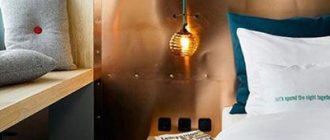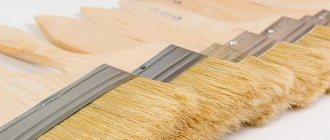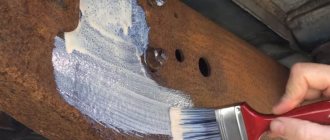Choosing colors for decorating a room is a complex process. Bronze color is one of the options that can give the overall appearance of the space unusual and luxurious. However, its use requires knowledge of which shades bronze can be combined with, and you should not use too many items of a given shade, so as not to overdo it. The rules for choosing bronze-colored items for the interior, where it is desirable to make an accent, and the subtypes of bronze will be discussed in detail below.
What color is bronze, why is it called that?
Bronze belongs to the yellow palette, there are different shades from greenish to dark brown. The tone has a metallic tint when the surface is exposed to ultraviolet radiation. Refers to warm and rich shades, it all depends on the combination where the option is used.
If you place bronze near darker shades, it will appear light and complement the overall look. Used with pastel shades helps to accentuate the bronze color, giving an elegant appeal. Considering what tone needs to be added to combine with this type, professionals suggest choosing a dark option or light colors.
You can skillfully combine it with almost all shades; it is important to choose the appropriate tone for a particular case. The use of bronze is popular not only for interior design, but also for clothing and hair dye.
Cars can also be supplemented with accessories, or even be completely bronze, so the import of a bronze Range Rover to our country was unique; some motorists like to install wheels in this color.
The tone has a metallic tint when the surface is exposed to ultraviolet radiation.
Tools and accessories
Carrying out painting work on any surface, including metal, requires the prior acquisition and preparation of the required number of devices and special accessories.
To prepare the surface:
Which is better: heated floors or radiators?
Warm floorBatteries
- metal bristle brush,
- sandpaper of various sizes,
- possibly an angle grinder,
- drill with special attachments for cleaning metal,
- if it is necessary to remove old paint - a hair dryer and scrapers,
- rags.
For applying primer paint and varnish coatings:
- paint brushes of various widths, hardness and sizes,
- artistic brushes (if delicate works are required),
- various types of rollers,
- foam elements,
- It is possible to use a painting console.
- Paints and varnishes and solvents.
- Accessories in the form of various containers and more.
Important! Work on painting surfaces and elements should be carried out in a well-ventilated area or outdoors to avoid poisoning from fumes of paints and solvents. At the same time, compliance with fire safety rules must be ensured: exclusion of sources of fire, smoking and the possibility of sparking.
Shades of bronze paint, how to combine with other colors
Bronze design is suitable for medium-saturated tones; the best combination is obtained when autumn shades are used. The option is perceived interestingly when a contrast of warm and cold shades is used, but if only warm types are used, then an unusual result of mystery is obtained.
Using this color, you can enhance the color scheme, being a brown subspecies, they get a calm design due to their proximity to the natural type.
To select the appropriate shade of paint or material for finishing furniture that is purchased to order, it is most convenient to use the RAL scale. There are all shades of bronze here.
Bronze design is suitable for medium-saturated tones; the best combination is obtained when autumn shades are used.
Options for how different colors are combined with bronze:
- with pink you get a romantic mood, you need to create a soft combination, the use of warm types is suitable;
- there is an intersection with red due to the proximity in warmth, and red also goes with bronze, so they look harmonious together;
- The shades are very close to orange, because, in fact, orange is a bright type of brown, so bronze can be called a subshade of orange; together they look light and unobtrusive, gaining depth in the design;
- With yellow is also a related variant. Yellow is a light type, for this reason a contrasting effect is obtained when the colors are combined together;
- With green, you can get a natural, natural envelopment, but you should choose deep and dark types of greenish, rather than bright and light shades;
- With cold green, you can get a contrast effect, but while maintaining naturalness, it is important to choose light types of cold green, without excessive brightness;
- With blue, an option that people like to use for various surfaces, the best is considered to be the use of marine types, a contrasting combination is formed;
- With purple, and you can also use lilac types, the result will be exquisite;
- With brown, a transition of tones is achieved; due to the metallic shimmer, a deep design is obtained;
- With white, black, beige, gray you can get a complement to bronze; they emphasize the main tone.
With brown, a transition of tones is achieved; due to the metallic shimmer, a deep design is obtained.
How to paint metal like old bronze
30.09.2015
Today I want to share the painting principle that I use for the vast majority of my products. Very briefly, this principle is formulated as follows: all recesses must be darkened, all protrusions must be lightened.
This makes your sculpture more expressive, emphasizes all the created forms, and at the same time - unlike plain painting - hides minor imperfections.
I want to show the method that I use myself, using the example of three painting schemes: metal, lava and wood.
Painting for metal
You will need:
— dark matte acrylic paint “Acrylic Hobby” (for example, black or brown);
— metallic acrylic paint “Decolor” (one or more colors);
— brushes (I prefer synthetic ones);
- sponge with a “scratching” texture;
- a regular sponge (for smooth surfaces).
For this painting I used a horn made from latex.
After degreasing the surface, apply the darkest matte paint - I usually use black. At this stage, you need to paint the product as thoroughly as possible, without leaving white spots - this may require painting in two stages.
Apply the first layer with a brush, moving along the texture, painting all the indentations. Let the paint dry - while it is wet and glossy, you may not notice that you missed some areas, if necessary, add a second coat.
Black color imitates patina.
Apply the next layer of metallic, starting with the darkest color, in our case it is antique bronze.
If at the first stage the paint should be slightly watery and cover everything as much as possible, and you need to move along the texture, then here the paint should be as dry as possible and it should be applied across, not allowing it to get into the recesses.
A sponge with a large “scratching” surface is optimal for application. In the absence of one, you can get by with an ordinary sponge, but before each application of paint to the product, wipe off the excess - for example, on paper.
The paint is applied with short, scratching movements, highlighting only the most prominent areas; stamping movements. The “newer” the product should look, the more metallic it should be applied.
When painting smoother, non-textured surfaces, I apply the final layers with a regular sponge to make the surface look more uniform and polished.
This painting principle imitates what happens to real metal: the patina accumulates in the depressions, and the metal is visible in protruding, polished areas.
You can stop at the previous stage. If you want to give the product a more interesting look, you can add other colors. We continue to apply them with a scratchy, dry sponge, trying to cover even less surface area than in the previous step. Here, the second layer was applied to the Emerald Decor, and the third (only to the ends of the horn rings) was Heraldry Gold.
Result:
Wood painting
You will need:
— several shades of matte acrylic paint (black, brown, ocher, etc.);
- brushes;
- an ordinary sponge.
The painting scheme is the same, with minor reservations, as the previous one. In this case, an amulet made of self-hardening plastic was used. At the sculpting stage, horizontal grooves were applied to the amulet to imitate the texture of wood.
1. Having degreased the surface, apply black paint with a brush, making sure that there are no white areas left.
2. Apply a second layer of brown paint (in this case I used a regular sponge), trying to paint most of the recesses, but not completely.
3. Apply a third layer of lighter paint (ocher will do) using a sponge. Before each application of paint, we remove the excess on a sheet of paper, so each time there is little paint on the sponge and it is quite dry, so it only affects the protruding parts of the product, bypassing the recesses. Can be applied using stamping movements; scratching movements across the grooves.
4. The finishing touches are applied with a brush using the lightest paint (for example, yellow or ocher, slightly diluted with white). We move the brush strictly vertically, in the direction of the grooves, imitating the grain of the wood (still without going into the recesses).
Several light stripes running parallel to each other add a more woody look.
Lava paint
You will need:
— several shades of matte acrylic paint “Acrylic-Hobby” (black, red, orange, yellow);
— brushes, including thin ones;
- a sponge with a “scratching” texture.
If you take the principle of “darken the recesses, lighten the protrusions” and turn it the other way around, you can simulate the internal glow of an object. Depending on the purposes, this can be an imitation of lava; green or blue glow. You can add luminescent or fluorescent paint or paint with “metallic” pigments to the recesses.
1. Paint the part a solid red color. We try to paint as carefully as possible.
2. Using a thin brush, paint the most important indentations red, carefully shading.
Using a “scratching” sponge, apply black dry paint across the recesses, without going deep.
The more “cooled” the lava is needed, the more black you should use.
Artist: Sergey
Isugi Voloshin
How to paint metal to look like old bronze - ooo-asteko.ru
Light antique painting is a fairly popular operation when creating various interiors. It is traditionally believed that antique items add an element of sophistication and luxury, emphasizing the style and wealth of the owner of the room. However, genuine antiques are highly expensive and often require restoration and special care.
It is much easier to simulate the aging of an object. And today this art is mastered not only by artists, but also by painters and simply amateurs. So, it will be quite possible for you to paint antique furniture if you set yourself such a task. But before you tackle your great-grandmother's chest of drawers, practice on something less valuable.
Methods for aging wood and other materials
There are several ways to age furniture and other types of materials:
- application of special compounds that change the appearance and properties of the top layer of coating (available for wood and metal work);
- painting with several paints of different colors so that the lower layers show through the upper ones;
- processing with sandpaper and other abrasive materials;
- the use of pigments that create the illusion of aging and some dirt.
Painting wooden elements
The most ordinary things can be turned into decorative furniture or accessories that are not inferior to antique items in terms of sophistication and the ability to create a special atmosphere in the room.
The question of how to paint antique wood arises when you want to make original and sophisticated-looking details using existing interior elements.
Antique painting of wood is quite possible at home; all you need is the most common tools. Before painting, it is necessary to carry out preliminary preparation of the object to be decorated.
Before aging a product, several stages of work are carried out:
- The surface of the object being processed is cleaned. Varnish, old paint, and any other coating are removed from wood. Those parts and fittings that are not planned to be painted are dismantled.
- The surface is polished and then cleaned from dirt and dust.
- The surface is primed with antiseptic compounds to avoid subsequent rotting or mold damage. The primer will also ensure the paint adheres better.
It is not recommended to use putty when preparing to age wood. With this design solution, the emphasis is on the presence of small defects in the wood, so you should not completely mask the flaws.
Creating the effect of dilapidation and wear
Artificially giving wood a shabby and dilapidated look is called brushing. The production uses sandblasting, during which soft fibers are removed from the top layer, causing the structure of the wood to become more pronounced.
When processing antique wood in a similar way with your own hands, the surface is first covered with matte acrylic paint. After it dries, abrasions are formed using a metal sponge or sandpaper, while individual areas can be affected more intensely to obtain a more natural look. The product is cleaned and a second coat of paint is applied.
At the end of the processing, it makes sense to go over the wood with a fine-grained abrasive tool.
Without using paint, you can achieve the effect of antiquity by painting wood with stain. This special material stains the wood by penetrating into its outer layer.
During absorption, the stain colors the wood in its natural color, while emphasizing the texture. There are also colorless compositions that perform exclusively protective functions.
The stain is applied with a cotton-gauze swab - a piece of cotton wool is wrapped in folded gauze. The composition is poured into the cotton wool so that it saturates it, but does not leak out when you press the tampon. Then the stain is rubbed over the entire surface. The process is repeated several times.
Sandpaper creates abrasions on the treated surface. The result is a natural wooden plane with pronounced texture and wear, characteristic of antique interior items.
Using a special varnish coating
To create a surface cracked by time, craquelure compositions are used, forming a coating on the product with a characteristic pattern in the form of uneven violations of the integrity of the paint layer.
This technique is called crackle; the “aging” of the product is carried out as follows:
- The product is cleaned and the surface is covered with a layer of paint. Please note that cracks in the final coating will have the same color as the first coat of paint.
- The dried paint is covered with craquelure varnish, which must be applied in one direction. A transparent film will appear on the surface.
- A base layer of paint of the desired color is applied over the craquelure varnish. This layer cracks under the influence of the craquelure composition, and the entire surface takes on a characteristic appearance with small cracks.
- To protect the aged surface, it should be coated with a transparent varnish.
Patina coating
To imitate the oxidation process characteristic of products made from certain metals, patina paint is used. This creates a rather interesting and unusual image of wood with the effect of antiquity and the color of bronze.
In order for a wooden object to acquire a specific antique look, its surface is first varnished to increase strength and wear resistance. When the varnish is dry, a thin layer of patina paint is applied to the surface.
After 30–40 minutes, the treatment is carried out with an abrasive tool, sandpaper or metal sponge. The effect increases with increasing intensity of such treatment.
Using a cloth, the resulting dust is removed, and the product is treated with transparent varnish.
The use of bronze color in design
Designers often turn to bronze to create unusual accents in a room. You can apply the shade for different styles. But the main rule is moderation; if there is too much bronze, you will get a loaded design that will put pressure and make the room uncomfortable to be in.
You can choose a variety of decorative elements that are painted bronze, or use figurines made of real bronze. There are finishing materials made in this tone.
In different rooms, the shade is designed differently; in order to think through the interior yourself, you can use the advice of professional designers.
You can choose a variety of decorative elements that are painted bronze, or use figurines made of real bronze.
Living room
Today, bronze chandeliers and other types of lighting fixtures are in particular demand among designers. If you install them in the living room, it will immediately be clear that the owner follows modern trends.
You can also place figurines or other accessories on the coffee table. Bronze-tone textile elements are used, and there may be pieces of bronze-tone leather on the pillows.
Bronze-tone textile elements are used.
Bedroom
In the bedroom, people who love this color can use it for big accents. But at the same time, many colors are not used; if this seems unacceptable, then only a few decorative elements can be placed.
If you choose bronzed wallpaper, then glue it with canvases of a different color. Curtains and other shades of bronze can be combined with the following shades:
- Ivory;
- White, beige;
- Gold;
- Turquoise.
In the bedroom, people who love this color can use it for big accents.
Kitchen
Manufacturers often install handles and other bronze-tone details on kitchen furniture, this allows you to immediately create accents in the room. There is no need to additionally purchase other decorative elements.
Household appliances of this color look gorgeous: oven, hood. They can also install taps and mixers to add more luxury to the interior.
Household appliances of this color look gorgeous: oven, hood.
Bathroom
In the bathroom, bronze is usually sufficient on faucets and taps. Or paint the piping parts with bronze paint to create an eye-catching addition.
The bathtub and sink look unusual in this shade; they will add sophistication to the overall background.
The bathtub and sink look unusual in this shade.
Hallway
In the hallway, frames on mirrors of this type can be used; an umbrella stand, a door handle, and a clothes hanger are also suitable. The dark bronze color will look beautiful in the hallway.
Dirt quickly appears in this room, for this reason you can use a combination with black. Bronze can also be present as parts in lighting fixtures.
In the hallway, frames on mirrors of this type can be used; an umbrella stand, a door handle, and a clothes hanger are also suitable.
Application of coloring compounds
Before painting metal bronze, it should be prepared.
Applying paint and varnish material to unprepared areas will not produce results.
Careful surface preparation is required to remove traces of dirt and rust. If you apply paints and varnishes to areas damaged by corrosion, this will not protect the metal from premature destruction.
Preparatory work
Rust and remnants of old paint must be removed from the metal surface. To carry out such work, the following methods are used:
- Rough mechanical cleaning with a wire brush or abrasive disc mechanisms.
- Sandblasting. The advantage of this method is penetration into hard-to-reach areas. The downside is the relatively high price of the unit.
- Cleaning surfaces with chemical compounds that react with rust and old paint. At the end of it, everything can be easily washed with a soft cloth.
When carrying out this work, you will need protective equipment to protect your face and hands from damage by small particles and reagents (goggles, gloves made of thick cotton fabric and a respirator).
After cleaning operations, a primer is applied to the prepared surfaces (in two layers). This improves the adhesion of the metal surface. At the same time, an additional moisture-proof polymer coating is used. Once the top coat of primer has set, you can begin applying the bronze dye.
Features of use in the interior
When creating any interior, selecting compatible colors is a necessary part of the work. This point requires special attention.
Selection using the Ralo table (RAL) is considered convenient and simple; it includes different sets where you can find the shade you are interested in, and then ordering the desired option will not be difficult, you won’t have to spend a lot of time describing in the store what tone is required, you just need to name the digital code, indicated on the scale.
There are also other color scales: Cmyk RGB, Hex, it is possible to convert tables from one to another, usually you need to convert the HTML code to Ral, since the scale is the most popular and well-known.
Bronze is not used for arranging large parts; usually these are elements in furniture, decor, and individual small accessories. Therefore, it is even more important to decide on the areas where it will be appropriate, so as not to overdo it, otherwise the perception of the design will be difficult, and you will not be able to achieve comfort.
Bronze is not used for arranging large parts; usually these are elements in furniture, decor, and individual small accessories.
Furniture
Bronze handles and lines can be used on kitchen cabinets. You can put a table or coffee table in this option. Large furniture in a similar tone is rarely used. But in a large room you can put a sofa upholstered in bronze leather, but in this case there should not be more large accents.
In a large room you can place a sofa upholstered in bronze leather.
Doors
Entrance doors are usually installed in bronze; the shimmer makes it more interesting and attractive. It is better to paint with powder paint or hammer paint, which will create a textured surface.
Entrance doors are usually installed in bronze; the shimmer makes it more interesting and attractive.
Curtains, textiles and other decor
Curtains in a dark shade will provide good protection from the sun's rays, which is necessary for a bedroom for a sound sleep. You can purchase curtains or curtain hooks. You can always arrange small figurines, use picture frames, panels, mirrors, pillows, bedspreads, etc.
Curtains in a dark shade will provide good protection from the sun's rays, which is necessary for a bedroom for a sound sleep.
How to paint metal to look like old bronze?
Main site MyKrasim.ru
The most common way to finish metal latticework, fences or railings is to antique paint the wrought iron items. Applying a noble patina and creating artificial abrasions make interior details especially decorative. Painting street fences and other structures with forging elements helps to mask minor assembly defects and protects steel products from corrosion.
Painting forged items bronze is one of the most popular methods of giving items an antique effect. Interesting:
Choosing anti-corrosion paint for metal
Aging materials
Metallic-effect paints are most often used to paint forged metal. These are compositions in which the transparent varnish (binder) contains a large amount of non-ferrous metal powder (copper, bronze, aluminum, etc.).
As a result, a decorative coating is formed on the structures, reminiscent of the surfaces of silver, bronze or brass products.
Decorating allows you to get the effects of gilding, and with aging techniques, make it slightly worn.
Decorative paint WS-patina is an acrylic composition for artistic finishing of forged products. Interesting:
How to paint a metal stove in a bathhouse?
Among modern materials:
- acrylic-based paints and varnishes, with gloss;
- polyurethane paint and varnish coatings (glossy and matte);
- nitro enamels;
- alkyd;
- three-component forging compounds with a rust transformer and primer (Zinga brands, etc.).
The main requirements for a dye when choosing are its purpose for working on metal, resistance to weather conditions and the content of anti-corrosion components. You can use both brush and spray formulations.
When purchasing patinas and paints for interior decoration, you must choose brands intended for interior use. A special mark or information on the packaging will help determine this. When finishing street structures, materials for external work are purchased. Three-component compositions are used without preliminary cleaning of the metal, removing only a loose layer of rust.
How to age metal yourself?
The easiest way is to paint with metallic paints and patina coatings. A varnish with a crackle effect is often applied over the base layer, which creates a network of small cracks and imitates the aged surface of polished copper or its alloy.
Interesting:
Calculation of powder paint consumption for metal
Preparing a forged product for painting includes removing dirt and rust by grinding.
In order for the result to be good, and the coating to be durable and last a long time, the work is carried out in stages:
- Clean the forged product from dirt and rust. The main method is mechanical. The steel base must be cleaned and sanded using sandpaper with different grains. Remove traces of fat with a solvent (white spirit, etc.).
- Before painting, a layer of primer is applied to the metal. It will increase paint adhesion and allow you to create a thin and uniform decorative coating.
- It is more convenient to paint with metallized compounds with a brush, carefully treating the joints. Large, flat surfaces are easier to spray paint.
- Applying patina, craquelure, scuffs and creating other signs of aging. This is done with foam rubber swabs, a dry brush, and removing part of the paint layer.
Bronze painting
Antique cast bronze is an expensive way to decorate an interior, so most often they use imitations of cheap metals (forged steel, aluminum) or even non-metallic objects. Do-it-yourself painting with a golden-colored alloy and patination (old bronze darkens when exposed to air) helps give them an antique look.
Giving a monochromatic effect
Decorating as antique bronze begins with painting and giving the black metal an external resemblance to a casting from a non-ferrous alloy.
If the product is made using hot forging technology, it must be sanded to a clean and shiny steel surface.
A dark deposit of scale, which forms due to heating, can interfere with the even application of the dye or fall off during use, destroying its layer.
Cold forged and bent products are cleaned of dirt and rust. When using acrylic or polyurethane paints without solvent additives, it is advisable to clean them in the same way as for hot-forged products.
When using a three-component forge mixture, you can only remove what weakly adheres to the metal: a thick layer of rust, peeling old coating or dirt.
After removing deposits with sandpaper, coat the product with a metal primer. When using three-component color mixtures, this step is also optional.
After drying the primer layer according to the manufacturer’s instructions, proceed to painting:
- apply a layer of bronze paint of the desired shade to the product (dark or light, old bronze, etc.);
- dry the product until the coating is completely cured (the minimum period is specified by the manufacturer and is about 24 hours);
- paint again, dry and apply 1 more layer;
- The product, ready for aging, will acquire a uniformly golden surface with a shine characteristic of polished bronze.
To achieve antique bronze, special paint and varnish coatings are used, which are applied using the contour method to the product.
Achieving the effect of antique bronze
Patination helps to achieve the effect of bronze darkened over time - painting the surface with special compounds (for example, WS-Patina or others). Translucent dark varnish can also be used as a patina. It is more convenient to apply patina with a brush; this will fill the recesses with a thicker layer, creating dark areas there. The bumps will be lighter.
The final stage is the application of light bronze paint to the highest points of the relief. When using bronze products, these protruding points are polished upon contact with hands (for example, railings, handles, etc.), they look lighter and shine.
This effect can be artificially created with a semi-dry brush or foam sponge with a minimal content of coloring composition. Using a tool, blot all protruding parts of the pattern.
After glazing, the product is allowed to dry again and coated with varnish. It will protect the results of the work done from rapid abrasion during operation and accidental mechanical damage.
Antique Brass Painting
Decorative paint for forging can also imitate another beautiful alloy - brass. Like bronze, it has a warm golden hue. The technology of painting for brass is reminiscent of decorating for bronze with patina.
The following method can be used:
- 1 layer of brass paint is applied to the cleaned and primed metal;
- after drying, cover the product with craquelure varnish: the coating forms small cracks;
- to enhance the expressiveness of the coating, paint over the varnish with burnt umber or translucent dark varnish, applying a thin layer and trying to rub it into the cracked surface;
- After drying, the product is coated with transparent acrylic varnish.
Painting in several layers
With the help of multi-layer coloring, the effect of an aged object, which was previously often repainted, is achieved. This antique painting of furniture is based on the factorial characteristics of wood and color differences.
The selected primary color is applied to the surface. This layer should be thin, so that the wood pattern is clearly visible. An abrasive tool creates abrasions and the product is painted with a second color. This layer is applied with light, careless strokes.
For additional realism of the color, in some places the second layer of paint is shaded so that the main background appears.
Aging of metal
New metal parts do not always fit into a sophisticated and thoughtful interior, primarily due to the presence of a characteristic shine. The use of antique metal objects is not available to everyone, so it is more advisable to artificially create the effect of antiquity using imitation paints or special surface treatment.
You can paint antique metal with your own hands sequentially as follows:
- The surface of the product is degreased and treated with a primer to improve the quality of subsequent painting.
- After the primer has dried, the product is painted over with metallic paint.
- When the paint is completely dry, it is evenly treated with a craquelure primer, which forms a transparent polymer film during the fixing process.
- The surface treated with this primer is covered with a craquelure composition, which adds characteristic cracks and gives the metal product the appearance of an antique item slightly touched by corrosion.
In addition, to give metal an antique effect when painting, you can use various pigmenting compounds. For these purposes, umber is often used, a mineral pigment that is resistant to light and alkalis.
Burnt umber is applied in a small amount to a piece of fabric and rubbed into the painted surface. The pigment remaining in the cracks of the coating completes the look of the antique item.
Painting brick walls
Brick itself often has a rather retrograde look, so painting such antique walls seems to be the simplest and is done by covering it with acrylic paints in the desired colors. Antique brick painting differs from conventional painting by a special method of applying acrylic.
Use in interior decoration
There are many finishing materials available in this paint. Then the general background for the room is immediately set; modern design allows you to combine different materials to create an unusual design.
Modern design allows you to combine different materials to create an unusual design.
Ceiling, floor and walls
Wallpaper with a corresponding pattern is glued to the walls, or you can make one wall in this color and cover the rest with other shades. The surface can be painted in any tone; there are also tiles, although in this case it is better to switch to a lighter slab. You rarely see an option like this on the floor.
White colors are often used on the ceiling, but beams in bronze are added in a multi-level type, or ceiling plinths are glued on, and chandeliers are added.
The surface can be painted in any tone.
Interior examples
More often, bronze is not used for the “High-Tech” and “Art Deco” styles; in other options, such coloring is possible. In modern styles, gray color is relevant, and bronze can complement it. For example, in the kitchen, gray serves as the main background, and bronze will be the bar stools, lighting fixtures and accessories. Textile accents are placed in the living room and curtains are hung.
In modern styles, gray color is relevant, and bronze can complement it.
The bronze color has not lost its relevance and can help create a modern design in any room. It is important to skillfully use the luxury of the material; its excessive presence will lead to the opposite result and create heaviness in the visual perception of the interior.











